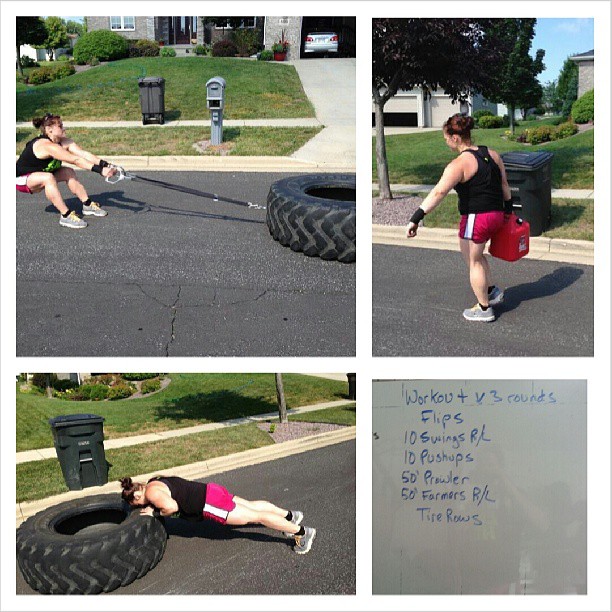
by | Oct 29, 2014 | Building Muscle, Cardio, Fat Loss / Cutting, Motivation, Nutrition
 With the ever-increasing popularity of intense workout programs like CrossFit, metabolic conditioning, or metabolic resistance training (MRT) seems to be a fitness trend that’s here to stay.
With the ever-increasing popularity of intense workout programs like CrossFit, metabolic conditioning, or metabolic resistance training (MRT) seems to be a fitness trend that’s here to stay.
These workouts tend to be intense, impressive, and very cool-looking. Typically, they have the added benefit of giving you a goal to work towards (beat the clock!). Who doesn’t want to flip a big heavy tire, beat things with hammers, and carry around heavy weighted objects as fast as possible?
If you’ve done your part, by the end of the workout, you’re exhausted, sweating from head to toe, and sprawled out on the ground, hoping someone will bring you a protein shake (or maybe a gallon of Ben and Jerry’s…).
Obviously you’ve just had a great strength training workout, right?
Not necessarily.
What is Metabolic Resistance Training?
It can be confusing to understand exactly what this term means since this term is thrown around pretty haphazardly in the fitness world. It is not just a bunch of random exercises done as quickly as possible.
Simply put, Metabolic Resistance Training is a form of metabolic conditioning. The purpose of metabolic conditioning is to increase the efficiency of one of the three pathways used in exercise metabolism. Metabolic conditioning has the added benefit of conditioning the muscles to better use to fuel delivered to them. Ultimately, this should result in a better capacity to burn fat.
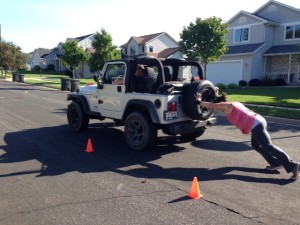
I do love pushing vehicles as a supplement to my serious strength training workouts!
Metabolic conditioning can be a great tool if your goal is fat loss. Not only does metabolic conditioning burn tons of calories during a workout, it also increases caloric burn in the 24-48 hours after your workout. This is due to excessive post-exercise oxygen consumption (EPOC). There are various different types of work to rest periods intended to increase EPOC.
A few examples are:
Tabata: 20 seconds of hard work, followed by 10 seconds of rest for 8 total rounds
30 On/30 Off: 30 seconds of hard work, followed by 30 seconds of rest for 6 total rounds
Circuits: Perform 3-6 exercises in a row with minimal to no rest between sets. These exercises should follow a logical pattern and should include elements of pushing, pulling, squatting, hinging, and carrying objects.
Energy Systems – The Goal of MRT
The primary goal of metabolic conditioning is to increase the efficiency of one of three metabolic pathways used in energy metabolism.
Creatine Phosphate Pathway: Also referred to as the Immediate Pathway, this energy system is responsible for providing short (less than 10 seconds) bursts of energy. This is the energy pathway utilized when performing quick power exercises like Olympic or powerlifting-style lifts or sprinting. It takes this energy system about three to five minutes to recover to its fullest potential.
Glycolytic Pathway: Also referred to as the Intermediate Pathway, this energy system provides the energy required for short, intense activities lasting one to four minutes. If you are completing high-intensity cardio intervals or doing multiple reps of a particular exercise, this is the pathway being utilized. It takes this energy system about 1-3 minutes to fully recover.
Aerobic Pathway: Also referred to as the Long-Duration Pathway, this metabolic pathway provides the energy required for longer-duration exercises of moderate-intensity work. This energy system can provide energy for hours of activity, since it has a limitless reserve (fat) to draw upon.
The energy system being conditioned by these workouts is largely determined on the rest period between sets. When structuring a metabolic resistance training circuit, it is important to keep the end goal in mind! The goal is NOT to throw weights around as fast as possible! These workouts should be well structured in order to maximize results.
It is important to remember that regardless of the activity performed, there is always some crossover between energy systems.

Metabolic conditioning is a fun way to get some cardio in, but nothing beats strength!
Is MRT the Same as Strength Training?
MRT typically involves weighted objects such as tires, battle ropes, farmer’s walks, sandbags, and kettlebells. These weighted objects are lifted in rapid succession, and the intensity is kept very high.
However, it is important to remember that the main goal of these workouts is not to maximize strength and to build muscle. The main goal of these workouts is to better utilize energy stored in the body. The primary goal of these workouts is more maintaining strength levels than gaining strength and adding muscle mass.
It’s key to remember that metabolic conditioning is not meant to be a haphazard, random bunch of exercises thrown together with the goal of burning a bazillion calories. These types of workouts are an advanced technique. So advanced in fact, that they are what many elite athletes turn to when they have reached their potential and are simply trying to maintain their current level of fitness. For the average recreational exerciser, it is important to complete these workouts under the supervision of a skilled trainer or strength coach.
The bottom line? You should view MRT workouts as a highly effective form of cardio, along the same lines as HIIT, meant to burn fat. These workouts are not intended to replace conventional strength training.
Is MRT right for you?
MRT can be a fantastic tool in your fat loss arsenal, provided that all other key elements are on pointe.
 Alwyn Cosgrove, author of the best-selling series New Rules of Lifting, who has a great reputation for results-driven fitness, has come up with a Hierarchy of Fat Loss that can serve as a great checklist to go through when evaluating whether and how new training philosophies will help you reach your goals. You should think about approaching the following elements in order. As long as you are achieving the results you desire, even if progress is slow, there is no reason to add elements further down the list. Stay patient and trust the process!
Alwyn Cosgrove, author of the best-selling series New Rules of Lifting, who has a great reputation for results-driven fitness, has come up with a Hierarchy of Fat Loss that can serve as a great checklist to go through when evaluating whether and how new training philosophies will help you reach your goals. You should think about approaching the following elements in order. As long as you are achieving the results you desire, even if progress is slow, there is no reason to add elements further down the list. Stay patient and trust the process!
1. Nutrition If your ultimate goal is to lose fat and increase lean muscle mass, start with nutrition. Keep it simple, and don’t overthink things. Your first step is to make sure that you are eating enough calories to support a healthy metabolism and maintain your lean muscle mass while you are losing fat. The more muscle you have, the higher your metabolism, so don’t sacrifice your lean mass for a smaller number on the scale! After you have made sure that you are taking in a sufficient amount of calories, look at your protein. A great goal is to take in approximately 1 gram of protein per pound of body weight. Take in plenty of healthy fats, and round everything out with some carbohydrates.
2. Nutrition Yes, it’s that important! Until you get your nutrition on pointe, there’s no point in prioritizing anything else! Activities that burn calories, maintain and promote muscle mass, and elevate metabolism Our metabolism is largely determined by our resting metabolic rate (RMR). RMR largely depends on how much metabolically active tissue (AKA muscle!!!) you have. Therefore, activities that increase RMR by maintaining or gaining muscle mass should be of next importance. A solid, periodized strength training program utilizing heavy weights with well-managed rest periods will accomplish this goal. Your strength training program should include plenty of compound movements like the squat, pull, push, lunge and hinge. Depending on your split, you should be lifting heavy weights 2-4 times per week. Bonus points here if your strength training program uses percentages of 1RM to determine your training loads! Circuit training, high-rep, low weight workouts, and metabolic conditioning do not fall into this category. Some of our favorite recommendations for a solid strength training program include STS, Stronglifts, and New Rules of Lifting for Women.
3. Adding in activities that burn calories and elevate metabolism. This is where activities falling under the realm of metabolic conditioning come in. Metabolic resistance training, HIIT, circuit training, and tabata training are powerful fat loss tools. They are far superior for producing results than traditional, steady-state cardio. If you have your nutrition on pointe, are killing your strength training workouts, and not seeing the results you desire, you may wish to experiment by adding in 1-2 short metabolic conditioning workouts each week. These are meant to supplement, NOT replace your strength training program. These workouts are very taxing and intense, and you may find that by adding them in, your appetite goes soaring through the roof! Make sure that you are continuing to fuel these workouts and getting plenty of recovery time. Adding a short metabolic finisher to the end of your workout might be a better option if you are new to this type of training or are short on time.
4. Activities that burn calories but don’t necessarily maintain muscle or elevate metabolism. If you still have additional time to devote to your training, you might consider adding in a steady-state cardio workout. These workouts will burn calories, but do not put you at any significant metabolic advantage. You should be aware that these types of activities can work against you if your goal is to build or even maintain your current muscle mass. Therefore, steady state cardio should be included as a last resort, only if you are making sure that these activities do not put you in too large of a caloric deficit, and only if you truly enjoy these types of activities.
 Becca is a busy wife and homeschooling mother to five children ages 5 to 13. About three years ago, she embarked on a journey to health and fitness that resulted in the loss of approximately 100 pounds. Today, she is a competitive powerlifter and strongwoman who loves ice cream and deadlifts. As an ISSA certified personal trainer, she is passionate about helping women to get started on a lifestyle of strength and fitness.
Becca is a busy wife and homeschooling mother to five children ages 5 to 13. About three years ago, she embarked on a journey to health and fitness that resulted in the loss of approximately 100 pounds. Today, she is a competitive powerlifter and strongwoman who loves ice cream and deadlifts. As an ISSA certified personal trainer, she is passionate about helping women to get started on a lifestyle of strength and fitness.

by | Oct 7, 2014 | Consistency, Increasing calories, Motivation, Testimonials, Transformations
 Hey there!
Hey there!
My name is Jeannetta! I have no idea where to start my transformation story, and I can’t give exact times and dates. What I can tell you is that finding this group on MFP is the best thing that could have ever happened to me. So, I think I’ll start on the topic of MFP.
I’d done MFP haphazardly in my mid 20’s. I’d always had weight issues. At a very young age, I was considered chunky. I was always bigger than my peers. In retrospect, I ate horribly as a child and teenager. The truth is, I didn’t know any better. We ate plenty of junk. Canned foods, fried foods, refined carbs, you name it. I don’t remember a balance of foods. Everything I learned about food and proper eating habits came to me in my early 20’s. At that point in time, I came home from college tipping the scales way over 200 lbs and about a size 22. I had horrible acne. I couldn’t fit into the latest fashions. I was fat, and I was over it.
When I moved home (Chicago) two things changed. I walked a hundred percent more. I took public transpo everywhere. That meant walking to and from the bus/L stops, walking from those stops to wherever I was going. Then back around again. Running to those stops sometimes. I mean, to go up and down L stairs and ramps, just commuting I had to be climbing a minimum of 13 flights of stairs in a day. If I wanted to go to the corner store/ bar/ most restaurants, I walked.
 The second thing that changed were my eating habits. I was eating better and didn’t technically realize it until later. I had more variety in my diet because of our food culture in Chicago (fresh foods, etc). One year later, I weighed in out of curiosity one day. My pants were falling off. I’d lost 30 lbs. That’s when I made the connection between activity and food. Soon after the weigh in, I went and got a gym membership. I not only was doing my daily commute walking, I was doing an hour of interval sprints or the elliptical, and weights maybe twice a week. I’d also started dabbling with that 1200 calorie number on MFP. Cleanses, psyllium tablets, senna tablets, and green tea became a huge part of my diet. I ate but was very restrictive. I was one of those, I don’t eat this and that people, but in private would max a pint of Hagen Daz half the fat vanilla ice cream. I would then justify it by the all the activity, and all the chicken, salmon, broccoli, and sweet potatoes one would enjoy. I would feel guilty for eating out with my girls. When I look back, I had an ED like a mug. I’d lost 60+ pounds, but was obsessed with losing more and getting smaller.
The second thing that changed were my eating habits. I was eating better and didn’t technically realize it until later. I had more variety in my diet because of our food culture in Chicago (fresh foods, etc). One year later, I weighed in out of curiosity one day. My pants were falling off. I’d lost 30 lbs. That’s when I made the connection between activity and food. Soon after the weigh in, I went and got a gym membership. I not only was doing my daily commute walking, I was doing an hour of interval sprints or the elliptical, and weights maybe twice a week. I’d also started dabbling with that 1200 calorie number on MFP. Cleanses, psyllium tablets, senna tablets, and green tea became a huge part of my diet. I ate but was very restrictive. I was one of those, I don’t eat this and that people, but in private would max a pint of Hagen Daz half the fat vanilla ice cream. I would then justify it by the all the activity, and all the chicken, salmon, broccoli, and sweet potatoes one would enjoy. I would feel guilty for eating out with my girls. When I look back, I had an ED like a mug. I’d lost 60+ pounds, but was obsessed with losing more and getting smaller.
It became harder and harder to maintain. Even though I was doing all the “right” things. The moment I would take a break from working out, I swear 10 lbs would show up so quick!!!!! Even still, I maintained the weight loss, give or take the ten lbs, for almost four years. When I look back, my actions were crazy. I’d started eating more fresh foods, and less prepared/processed foods, which was great, but that all came with binges.

Here I am, covering myself with my children’s bodies.
Fast Forward.
I got pregnant, and had two babies between 2008 and 2010. Yeah I know, my lifestyle changed. I began driving everywhere because I didn’t want to be on public transpo with two kids under two. I ate when I could. I had very little time to work out. The weight piiiiiiled on. I cried and cried. I was miserable. I didn’t want to take pictures. I didn’t want to be intimate with my husband. I was tired all the time. Depressed. Ashamed. I became the mom who let herself go. I’d promised myself I’d never be overweight again, and there I was, fat and ashamed with no self-love —constantly feeling sorry for myself.
My husband, he got me right together one day. He said to me, “I love you no matter how big or small you are, but I am soooo tired of you crying about it. If you want to change it, I’ll take the kids to school so you can get up and work out”. I started working out at home in the basement with a friend of mine to a Beach Body program that was sooooo fun! I was burning like 7-800 cals a session. But, I was also following a 1200 calorie schedule. I wasn’t losing a lb! I did feel better cardiovascular wise, but I was Hangry and I wasn’t losing any weight! That was the day I decided to utilize MFP to its fullest potential. I was going to go through profiles, see who was the fittest in their pictures and friend them.
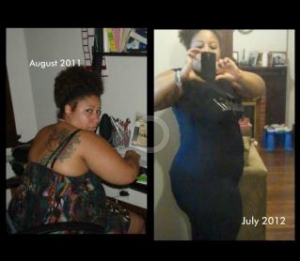 That’s how I found Lucia. Call it luck or whatever, but I really believe I found her by the grace and mercy of The Lord. I’d started down the supplement trail again. I was doing the BB shake, protein shakes, green tea extract, enzymes, etc! I really, I mean in my gut knew I was not supposed to be taking all this crap. I was desperate again. Upon stumbling on her profile, I remember admiring her gun show. I remember doing a double read of her “About Me”. I remember reading she ate over 2500 calories a day. I remember looking back at her picture and thinking WTF? She is LYING!!! I remember going to her diary and reading her log, and my mouth dropping open. I remember being confused. So I friended her, I started going through her friends list and noticing all the EM2WL peeps, and I went on to friend others. I remember sending her the most desperate message. All I remember from that reply was metabolism reset, and Scooby’s Calculator. That’s when the research began. I felt bamboozled. All these years of starvation and excess cardio???? Even though I thought these ideas were crazy, you know, like the idea of EATING. I done everything else crazy, so I took my cals up from 1200 to 2500 in one day. By the end of the week, I’d lost 9lbs. It wasn’t a great 2500 calories. I ate whatever I wanted for about six months. I leveled out at about a 15 lb loss over the next year and a half.
That’s how I found Lucia. Call it luck or whatever, but I really believe I found her by the grace and mercy of The Lord. I’d started down the supplement trail again. I was doing the BB shake, protein shakes, green tea extract, enzymes, etc! I really, I mean in my gut knew I was not supposed to be taking all this crap. I was desperate again. Upon stumbling on her profile, I remember admiring her gun show. I remember doing a double read of her “About Me”. I remember reading she ate over 2500 calories a day. I remember looking back at her picture and thinking WTF? She is LYING!!! I remember going to her diary and reading her log, and my mouth dropping open. I remember being confused. So I friended her, I started going through her friends list and noticing all the EM2WL peeps, and I went on to friend others. I remember sending her the most desperate message. All I remember from that reply was metabolism reset, and Scooby’s Calculator. That’s when the research began. I felt bamboozled. All these years of starvation and excess cardio???? Even though I thought these ideas were crazy, you know, like the idea of EATING. I done everything else crazy, so I took my cals up from 1200 to 2500 in one day. By the end of the week, I’d lost 9lbs. It wasn’t a great 2500 calories. I ate whatever I wanted for about six months. I leveled out at about a 15 lb loss over the next year and a half.
 I was still doing a massive amount of cardio and very little lifting. I’d eased up on the supps. Our family moved to Georgia. I didn’t work for 6 months. I worked out an hour a day, but was sedentary the rest of the day. I was still eating 2500 or more cals, not making adjustments for my activity levels. I gained 30 lbs.
I was still doing a massive amount of cardio and very little lifting. I’d eased up on the supps. Our family moved to Georgia. I didn’t work for 6 months. I worked out an hour a day, but was sedentary the rest of the day. I was still eating 2500 or more cals, not making adjustments for my activity levels. I gained 30 lbs.
I followed a few other eating more groups and found that weight lifting, building your metabolism, moderation, and eating for your individual activity levels were all these groups had in common. By this time though, I’d started feeling really crummy. I was tired all the time, depressed/anxious, low libido, bloating, constipation, rapid stomach fat gain etc. I had a laundry list of things going on. I’d started cutting cals slowly, cutting some of my cardio and replacing with weight training like I’d learned from the groups, and eating moderately, but even still, I wasn’t losing, and I wasn’t physically feeling well. I went to the doctor. I found out I was insulin resistant. Yep, I was on my way to having diabetes. I sigh even typing this. I never thought I’d be here. I had a cry fest for a couple of days, mostly because my doctor prescribed me the Atkins or South Beach DIET. I was so over diets at this point. I’d been on a diet my whole adult life. I did not want to go on a DIET. I was tired of restricting. I was at a place where I’d started to accept my body for the way it was, and appreciate what it could do. And now, the doctor wants me to go on another restrictive diet. A diet I knew I would fail miserably at, again. I’d already been on both previously and hated every minute of it.
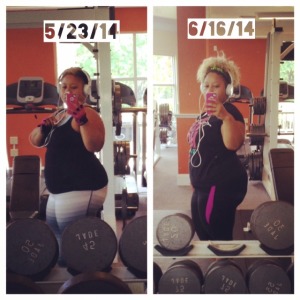 But I’m a resourceful old bird. I am. I wasn’t going to be defeated by this. I refused the negative thoughts and started to claim my victory. I headed straight to the diabetes association website. This is where I learned the words glycemic index. I learned how foods effect your insulin, and how insulin contributes to fat loss and gain. I’d already won just by having this information. I was ready. After studying for a few days, I’d found that the damage had already been done to my cells, and while I could become less resistant, there was no science to prove you could reverse the damage to your cells. There was overwhelming science that backed the fact that you could control your insulin levels and keep them normal by the foods you eat. Those foods are medium to low glycemic index foods. The best part, was that I could still have carbs. What? Even carbs high on the glycemic index could be eaten sparingly.
But I’m a resourceful old bird. I am. I wasn’t going to be defeated by this. I refused the negative thoughts and started to claim my victory. I headed straight to the diabetes association website. This is where I learned the words glycemic index. I learned how foods effect your insulin, and how insulin contributes to fat loss and gain. I’d already won just by having this information. I was ready. After studying for a few days, I’d found that the damage had already been done to my cells, and while I could become less resistant, there was no science to prove you could reverse the damage to your cells. There was overwhelming science that backed the fact that you could control your insulin levels and keep them normal by the foods you eat. Those foods are medium to low glycemic index foods. The best part, was that I could still have carbs. What? Even carbs high on the glycemic index could be eaten sparingly.
I made the commitment to a total lifestyle change. Well really I didn’t have a choice, I could choose to change or live with a disease I didn’t want. So, I incorporated more foods low to medium on the index, weight training five days, and cardio 2-3 days for no more than 30 minutes. I also try not to be so sedentary during the day. I don’t count calories anymore. I eat when I’m hungry and when I’m full I stop. I drink plenty of water, and get my rest. The glycemic index has been the way for me to get my insulin levels under control. I was able to get my numbers back into normal range without the use of diabetes meds. What’s even crazier is that, the moment I got my insulin under control, the weight started flying off. And guess what? I’m not starving anymore.
 I’m nowhere near done, but I am on my way. As of four weeks ago I was down 14 lbs, I’m due to go to the doctor this week. I’m averaging about 5-6 lbs a month as far as loss. I’m getting stronger with every lifting session, and I increase my weight every two weeks. I super set a lot, and lift with intensity.
I’m nowhere near done, but I am on my way. As of four weeks ago I was down 14 lbs, I’m due to go to the doctor this week. I’m averaging about 5-6 lbs a month as far as loss. I’m getting stronger with every lifting session, and I increase my weight every two weeks. I super set a lot, and lift with intensity.
Hang in there! Listen to your body. If you need help, see a physician. But most of all, don’t give up on yourself. Be your biggest cheerleader and your biggest competition. If I can overcome, I know you can too! I hope this helps someone. My story is a “to be continued”.

by EM2WL | Sep 24, 2014 | Building Muscle, Fat Loss / Cutting, Motivation
 You may have noticed, since beginning weight lifting, and feeding your body properly, that some clothes still fit your new shape while others fit, well…differently. You look great in yoga pants, yet you can’t seem to get your jeans over your butt. You look great naked, but when you put on those shorts your thighs look like… “quadzilla??” Perhaps you weigh the same as you did before, or maybe you’ve gained a few extra pounds. A quick measurement check reveals that though you have lost inches in some areas, you’ve actually gained inches in others.
You may have noticed, since beginning weight lifting, and feeding your body properly, that some clothes still fit your new shape while others fit, well…differently. You look great in yoga pants, yet you can’t seem to get your jeans over your butt. You look great naked, but when you put on those shorts your thighs look like… “quadzilla??” Perhaps you weigh the same as you did before, or maybe you’ve gained a few extra pounds. A quick measurement check reveals that though you have lost inches in some areas, you’ve actually gained inches in others.
Is this supposed to be happening?
The answer is: Yes. It is because your body composition has changed, in a good way! Body composition is the proportion of fat, muscle and bone that make up the body. It is measured by the percentage of body fat and the percentage of lean body mass that you have. Resistance training along with an appropriate calorie intake, and proper macronutrients is the foundation of these amazing changes.
When I decided to make fat loss my ultimate goal — by adding resistance training to my workouts — I assumed that meant I would automatically fit into a smaller size. I slowly saw the changes to my body in the mirror and I loved what I was beginning to see. I embraced the slimming in some areas and the new curves in others. But when I went shopping for new pants, I would get discouraged. The sizes and styles that I tried on, thinking they should fit…didn’t. The smaller sizes were a little too tight in the hips, the larger sizes were too big in the waist! When I tried on shirts, some were tight around the biceps while others were tight across the back and chest.
But I didn’t give up.
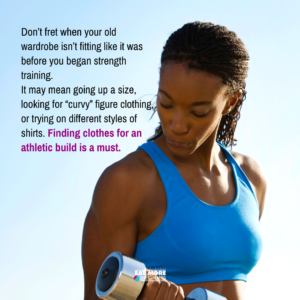 As I continued to try on different styles, sizes, and designers, I finally found a rack of designer pants that made classic, straight, and curvy fit. Yay! I chose one of each cut, in 2 different sizes. The curvy pant was made just for me. I turned from side to side admiring how awesome I looked and felt. But soon reality hit…
As I continued to try on different styles, sizes, and designers, I finally found a rack of designer pants that made classic, straight, and curvy fit. Yay! I chose one of each cut, in 2 different sizes. The curvy pant was made just for me. I turned from side to side admiring how awesome I looked and felt. But soon reality hit…
It was one size larger than what I thought I should be in. I found myself depressed over a number some guy put on a label inside a pair of pants. Shame on me!! I loved the way I looked and felt. I decided that it was time for me to ditch the number on the label in my pants like I did the scale!
So don’t fret when your old wardrobe isn’t fitting like it was before you began strength training. Look for a designer that makes clothes for your female figure. We really need to stop buying clothes made by designers who think women are shaped like 12-year-old boys. It may mean going up a size, looking for “curvy” figure clothing like I did, or trying on different styles of shirts, but finding clothes for an athletic build is a must.
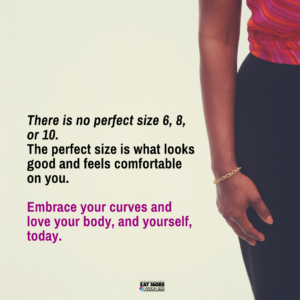 If you have been in the department stores lately you will also see beautiful long skirts and palazzo pants in gorgeous fall solid colors and prints that are perfect for figures between sizes. Many of these have elastic waistbands that will fit as you continue to lose fat, so you won’t have to buy smaller sizes! It’s important to choose clothing that not only looks fashionable, but also feels comfortable!
If you have been in the department stores lately you will also see beautiful long skirts and palazzo pants in gorgeous fall solid colors and prints that are perfect for figures between sizes. Many of these have elastic waistbands that will fit as you continue to lose fat, so you won’t have to buy smaller sizes! It’s important to choose clothing that not only looks fashionable, but also feels comfortable!
Remember, there is no perfect size 6, 8, or 10. The perfect size is what looks good and feels comfortable on you.
Embrace your new curves and love your body, and yourself, today.

by Trish Adams | Sep 15, 2014 | Consistency, Fat Loss / Cutting, Motivation
Self-doubt happens to all of us at some point in our lives. On the journey to reaching a specific goal, negative thoughts make us question if we can achieve the very thing that we set out to accomplish. It’s these negative thoughts, when left untamed, which can affect our actions and lead to negative results.
Our patience can be particularly tested when it comes to reaching physique, strength, fitness or health-related goals where results are slow, or we feel we have less control over the outcome. Learning to catch negative thoughts as they happen is key to avoiding the slippery slope of negativity and ensuring you stay on the path you have set out on with a grateful, and optimistic outlook.
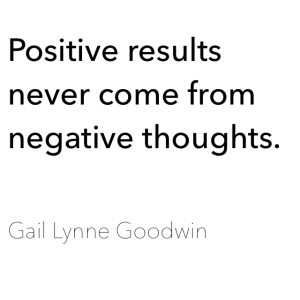 Let’s use this scenario as an example. You head to the gym on a Monday and have an awesome lift. You’re feeling good about yourself because you added 10 pounds to your bench and 20 pounds to your deadlift. In short, you feel like a BEAST!!! You wake up the next day, rush to the mirror and promptly start looking for changes, expecting to be rewarded for all your hard work (or…at very least, another glance at those gorgeous muscles you saw poppin yesterday). Instead you feel fluffy — not at all what you expected — and you’re holding water (100% normal following an incredible lift session!). Suddenly your attitude towards the day goes from “I’m ready for you!” to “Why should I even stay on track or hit the gym today?” Negative thoughts start to creep in and you’re convinced you have failed.
Let’s use this scenario as an example. You head to the gym on a Monday and have an awesome lift. You’re feeling good about yourself because you added 10 pounds to your bench and 20 pounds to your deadlift. In short, you feel like a BEAST!!! You wake up the next day, rush to the mirror and promptly start looking for changes, expecting to be rewarded for all your hard work (or…at very least, another glance at those gorgeous muscles you saw poppin yesterday). Instead you feel fluffy — not at all what you expected — and you’re holding water (100% normal following an incredible lift session!). Suddenly your attitude towards the day goes from “I’m ready for you!” to “Why should I even stay on track or hit the gym today?” Negative thoughts start to creep in and you’re convinced you have failed.
Wait. Wait, wait!
This is when you have to practice stopping those negative thoughts in their tracks. Try using the following tactics to keep your mind focused on the positive and stay headed in the right direction.
Remember how far you’ve come – On days where you’re struggling with the person in the mirror, or worse, the number on the scale, remember all that you have accomplished. Are you a reformed VLCD eater who now nourishes their body with the nutrients it needs? Are you a recovering binge-eater who no longer feels out of control when eating trigger foods? Have you overcome any physical challenges like being able to play with your kids without getting winded or, heck, maybe you can push a car! These are all victories that don’t reflect back to us when we are looking in the mirror or standing on the scale. Each and every one, no matter how big or small, should be acknowledged (often), celebrated, and used as fuel to push on.
Try something new – If you do the same routines week in and week out, it might be time for a change. Scratch that, i t most definitely is time for a change! Consider adding phases to your routine to be sure that you are getting the most out of your efforts. At a minimum, try a new exercise class, take your workout outside or invite a friend to the gym. Change it up. You will be amazed by your body’s ability to adapt to something new.
t most definitely is time for a change! Consider adding phases to your routine to be sure that you are getting the most out of your efforts. At a minimum, try a new exercise class, take your workout outside or invite a friend to the gym. Change it up. You will be amazed by your body’s ability to adapt to something new.
Be grateful for what you have – There are people who don’t have the health that allows them to get up every day and work out. Understand you are blessed to have this opportunity. View exercise as a way to thank your body for all it is capable of. Every day that you are able to push harder and get stronger is a gift.
Doubt can creep up at any time, not just during our weakest moments. Next time you feel a negative thought coming on, counter it with a positive one. Instead of thinking “my stomach looks puffy today,” try saying something like “I have strong, muscular legs.” Don’t let negative thoughts take you off the course you have set for yourself. Win these small battles one at a time. Your mind believes what you tell it, whether it is fact or fiction. Be sure you are feeding it positive thoughts.
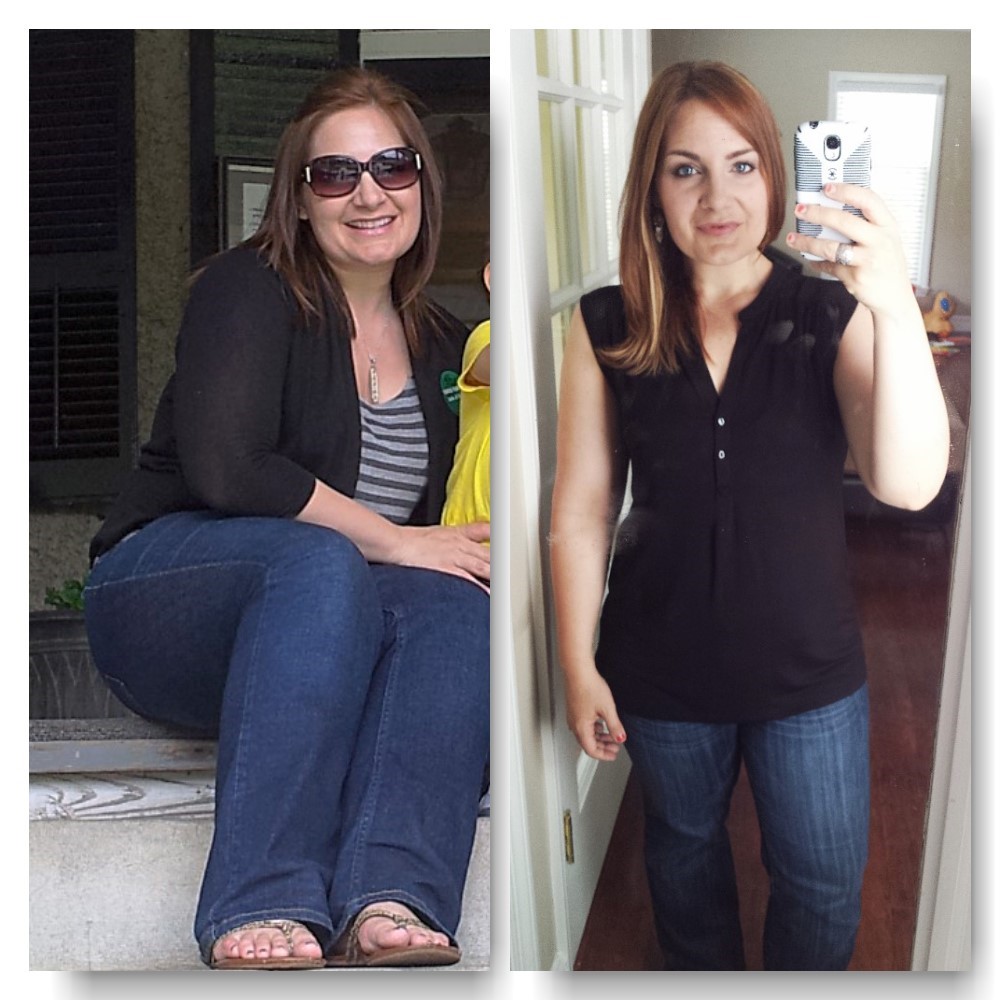
by | Jul 24, 2014 | Motivation, Testimonials, Transformations
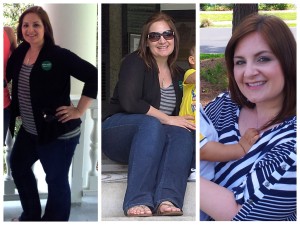 I found EM2WL in January 2014 and it was an answer to my prayers. EM2WL has forever changed my life, health, mind, and my relationship with food and myself. I am still certainly a work in progress, but each day I am closer to reaching my goals. I have lost 40 pounds over the past 7 months, and I credit the last 30 pounds to EM2WL. But more than weight loss, I have gained strength, confidence and a drive to move forward with my life.
I found EM2WL in January 2014 and it was an answer to my prayers. EM2WL has forever changed my life, health, mind, and my relationship with food and myself. I am still certainly a work in progress, but each day I am closer to reaching my goals. I have lost 40 pounds over the past 7 months, and I credit the last 30 pounds to EM2WL. But more than weight loss, I have gained strength, confidence and a drive to move forward with my life.
A little about me…I am a wife of 10 years (to an incredible husband who has loved me at every size) and currently a stay-home mom to my super active 2 year old boy. I struggled with the cycle of under eating/overeating for as long as I can remember. I was a heavy child and I became aware of diets (food restriction) and followed them from an early age. At age 7, my mom began taking me to a nutritionist weekly. I don’t remember it helping me as I was so young, but I do know that it communicated to me that I had a problem with my weight. My mom, having her own weight issues, was only trying to help me while I was young. At age 11, I remember being weighed at the doctor’s office and I weighed 133 pounds. I asked my mom if I weighed too much and I remember her carefully saying, “You could work on losing a little”. That day began a lifelong struggle of severe dieting and what I now recognize as disordered eating. At age 11, I put myself on a diet and lost 17 pounds. Of course I gained it right back and more as I grew into my teenage years.
Sports and activities filled my high school and college years, but the pressure to weigh less fueled my unhealthy eating cycles. I weighed anywhere from 160-180 and would yo-yo up and down easily. I would severely restrict calories for a few months and then massively binge…over and over and over…all on top of extreme exercise. If I managed to lose any weight, I would regain it all back through the binging…plus more. I tried often to purge, but thankfully, my body would not cooperate. These unhealthy cycles continued through my 20’s and early 30’s, throughout my married years, and through my first pregnancy.
My family went through a series of tragic events and multiple relocations and my weight began quickly increasing from the 170’s upward. In 2013, one year after my son was born, I reached my highest weight of 207 pounds and a size 18 at only 5’3. I had pretty much lost sight of myself and any goals I had once had. I was told I was an emotional eater. I hid stashes of food and sweets in my home and at work. I ate if I was happy and when I was sad. My biggest fear was that I would continue to live the rest of my life in that misery and set a negative example for my children.
 I knew low calorie and fad diets did not work, but I returned to them because I knew nothing different. I blamed my lack of success on lack of discipline, willpower, and emotional eating. I always felt like a quitter because I could not stick to anything. I had tried everything over the years – Weight Watchers, Medifast, Slimfast, Liquid Amino Diet, Six Week Body Makeover, Nutrisystem, low calorie, juicing, fasting, and starving. I would lose weight at first and then stall for weeks before giving up and overeating to compensate for the low calories and then gain everything back and more. Weight Watchers gave me partial success, but again I stalled after the first few months and couldn’t understand why since I was working out every day and not consuming any extra points or earned exercise points. I thought the weight should be melting off, but it wasn’t, and many weeks I actually gained. When I later did the calculations, I figured I was only eating 1200 calories on Weight Watchers. At one time I even trained for a half marathon and was running 7 miles a day. Little did I know that eating 1200 calories and running 7 miles daily would stall my weight loss for weeks. I felt defeated but I couldn’t give up.
I knew low calorie and fad diets did not work, but I returned to them because I knew nothing different. I blamed my lack of success on lack of discipline, willpower, and emotional eating. I always felt like a quitter because I could not stick to anything. I had tried everything over the years – Weight Watchers, Medifast, Slimfast, Liquid Amino Diet, Six Week Body Makeover, Nutrisystem, low calorie, juicing, fasting, and starving. I would lose weight at first and then stall for weeks before giving up and overeating to compensate for the low calories and then gain everything back and more. Weight Watchers gave me partial success, but again I stalled after the first few months and couldn’t understand why since I was working out every day and not consuming any extra points or earned exercise points. I thought the weight should be melting off, but it wasn’t, and many weeks I actually gained. When I later did the calculations, I figured I was only eating 1200 calories on Weight Watchers. At one time I even trained for a half marathon and was running 7 miles a day. Little did I know that eating 1200 calories and running 7 miles daily would stall my weight loss for weeks. I felt defeated but I couldn’t give up.
I knew there had to be a different way to approach weight loss and I wanted to find it. I started reading and researching about a different type of weight loss strategy…one that was maintainable. I committed to being happy with a .5 or 1 pound loss a week instead of trying/expecting to lose 3 pounds every week. I joined MFP in January (user name Jennbecca33) and started seeing people talk about how under eating can actually hinder and keep you from losing weight. During this time, I found the EM2WL group and I have not looked back! Something finally made sense and clicked for me.
The wonderful ladies in this group have taught me how to eat properly and eat ENOUGH (way more than I thought I could) so that my body could lose weight more easily. I learned that the low calorie diets in conjunction with working out simply did not give my body enough to lose weight properly, hence the weight loss stalling. Since then, I’ve committed to eating more to weigh less. I actually found that I did not need to do a reset, surprisingly. As I started slowly increasing my calories, my weight immediately decreased by a couple of pounds. I couldn’t believe it. I then increased my calories a little more, and again, I dropped a couple more pounds. I kept increasing until I found my maintenance level which is around 2100-2300.
This concept of eating more, or at a slight deficit, went against everything I had ever been taught about dieting. I now happily eat between 1800-2000 calories daily (-15% TDEE) to lose weight and I do all my workouts from home. When consistent, I average between .5- 1 pound loss per week. I am now incorporating heavier weight training (which I love!) to help reshape my body. I usually work out 4 times a week for about 30 minutes each – 2 or 3 weight lifting sessions and 1-2 workouts on the elliptical. My only permanent success has come from following the EM2WL lifestyle, and the best part is, I’m able to keep going because I’m giving my body enough food so that I’m not hungry, worn out, and irritable all the time. Since I have started allowing myself to eat more, I have not had even one binging episode, or even the desire to binge! Have I overeaten at times? Sure. But even then, I’m able to work it into my calories. I’ve come to terms with losing weight in a responsible and healthy manner and I am so motivated to know that I now have the proper tools to reach my goal.

Before and After
When I started EM2WL in January 2014, I weighed 195 and was a size 16. I had lost about 10 pounds on my own at that point. I have lost the last 30 pounds with EM2WL, for a total of 40 pounds. I still currently weigh 165 pounds and at 5’3 I wear between a size 8 and 10. I don’t really have a “goal” weight in mind anymore and I’m not stressing about it. When I get there, I will know. I still have quite a bit of fat on certain body parts that I want to lose. My hips and legs hold most of my weight, but slowly, even my legs are shaping up. I know I will always have thicker legs, and I’m ok with that. I look better now at 165 than I did at 145 (a weight I never maintained after 3 months on only 800 calories). EM2WL works. It will work for anyone. Eat at a smaller deficit so that it’s maintainable and so that you can keep going! Yes, it’s slower paced weight loss. But in the long run, you are able to keep it off. Keep muscle, build muscle!
The biggest change for me though, has been the mental shift about food. I no longer hate food. I really love food. I am not on a diet. Food is ok to eat and I do not feel guilty for indulging in moderation! There is nothing that I cut out of my diet. I love eating with my family and not having to cook separate meals every night. No more missed birthday dinners. I enjoy eating out and making healthy food choices. I will never again be tempted by low calorie dieting or a fad gimmick diet. EM2WL has given me freedom and it has truly helped me to take back my life.
Thank you to all the EM2WL moderators and members who have been so supportive and helped me and continue to help me through this journey. I have learned so much from you. You truly were an answer to prayer during one of the darkest and heaviest times in my life. I pray my story may help and encourage others now to trust this process as well. I look forward to posting an update when I reach my end goal!
Have you overcome disordered eating? Have an EM2WL transformation to share? Let us know! Be featured on our Transformation/Journey page by submitting your story to Success@EM2WL.com
Ready to begin your own Journey? Start here.
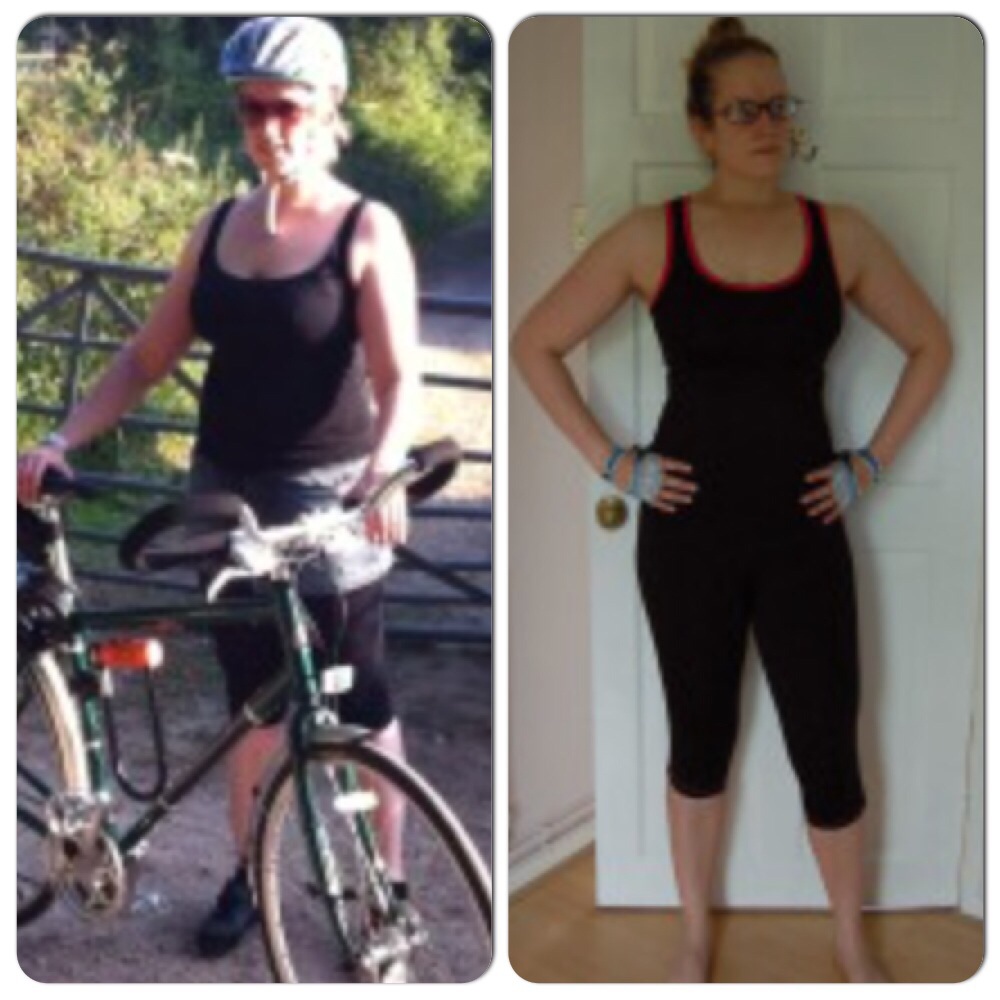
by | May 28, 2014 | Consistency, Fat Loss / Cutting, Motivation, Testimonials, Transformations
 I am almost two years into my EM2WL journey. Having been a classic yo-yo dieter since around the age of 15, I was introduced to MyFitnessPal by a colleague in April 2012 at the age of 29. I started out typically on 1200 cals and not understanding the necessity of eating back exercise calories.
I am almost two years into my EM2WL journey. Having been a classic yo-yo dieter since around the age of 15, I was introduced to MyFitnessPal by a colleague in April 2012 at the age of 29. I started out typically on 1200 cals and not understanding the necessity of eating back exercise calories.
I stalled out and lost will power pretty quickly and I wasn’t seeing the losses that I had done when eating that little when on diets in previous years. While hovering around the forums I soon started to notice mention of EM2WL and TDEE and BMR and it all got me thinking. I soon joined at EM2WL group and started reading all about the concept of losing weight by eating a small cut from TDEE. I tried out various calculators and was shocked to discover my estimated TDEE should be somewhere in the region of 2700 cals. No wonder I had been struggling to get through the day on 1200, which inevitably led to binges.
I decided to increase my calories to around 2200 in June 2012, around a 15% cut from TDEE. I started EM2WL at around 145 lbs and after a few months I stepped on the scale for the first time and found I had been maintaining. I was a little disappointed that my TDEE didn’t seem to be as high as the calculators put me, but I became to understand that I had lost a lot of muscle mass through my years of yo-yo dieting, leading to a suppressed TDEE. I then realised just how much harm I had unknowingly been doing to my body.
 At that point, rather than cut my calories, I increased them to around 2500 and started lifting heavier. At this level I slowly started gaining weight but I was enjoying strength training and enjoying nourishing my body well and hitting my macros.
At that point, rather than cut my calories, I increased them to around 2500 and started lifting heavier. At this level I slowly started gaining weight but I was enjoying strength training and enjoying nourishing my body well and hitting my macros.
Over the next 15 months I gained a total of 20 lbs, taking me up to around 165 at my highest. However, I was still fitting into the same clothes and my food intake varied between 2200 and 3000 calories per day. During those months there were only two days when I ate less than 2000 and that was when I was sick.
The added weight has helped me regain some of my lost muscle mass. So in January 2014, partly spurred on by the concept of being bridesmaid for a close friend at Easter, I decided to make a concerted effort at a cut.
I settled at around 1900-2100 cals Monday to Friday, allowing myself around 2500 cals Saturday and Sunday so I could still enjoy my favourite meals out and take-outs as I always had. By mid-April I had lost around 10 lbs and I finally started to see muscle definition in my arms, shoulders and calves. My thighs are firming up, and my belly and back have less fat than ever before. In the past when I had starved myself down to a size 4 I was skinny-fat and had a pot-belly.
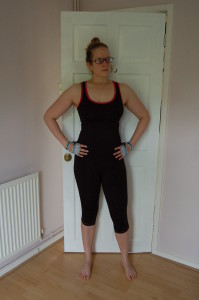 My TDEE is gradually increasing and I have now switched to maintenance for the summer, averaging around 2400 per day while focus on my lifting. I then aim to increase my calories again over the winter to try and add back more precious muscle. Over time I want to see my actual TDEE raised to where it should be based on my activity level. I currently cycle commute to work, strength train three times per week and do yoga or pilates once per week. I also enjoy an active outdoors lifestyle as much as the British climate allows, hiking and cycling when and where I can.
My TDEE is gradually increasing and I have now switched to maintenance for the summer, averaging around 2400 per day while focus on my lifting. I then aim to increase my calories again over the winter to try and add back more precious muscle. Over time I want to see my actual TDEE raised to where it should be based on my activity level. I currently cycle commute to work, strength train three times per week and do yoga or pilates once per week. I also enjoy an active outdoors lifestyle as much as the British climate allows, hiking and cycling when and where I can.
It’s been a long road and I’m still a work in progress but I am finally comfortable in my body, starting to love it a little bit more each day. I enjoy a balanced diet which allows me to eat all the foods I enjoy. I still can’t quite believe that I’ve found out that there really is a way to have it all.
I feel so positive about the future now and I couldn’t have got here without Kiki, Lucia and the EM2WL team. Thank you all so much!

 With the ever-increasing popularity of intense workout programs like CrossFit, metabolic conditioning, or metabolic resistance training (MRT) seems to be a fitness trend that’s here to stay.
With the ever-increasing popularity of intense workout programs like CrossFit, metabolic conditioning, or metabolic resistance training (MRT) seems to be a fitness trend that’s here to stay. Alwyn Cosgrove, author of the best-selling series New Rules of Lifting, who has a great reputation for results-driven fitness, has come up with a Hierarchy of Fat Loss that can serve as a great checklist to go through when evaluating whether and how new training philosophies will help you reach your goals. You should think about approaching the following elements in order. As long as you are achieving the results you desire, even if progress is slow, there is no reason to add elements further down the list. Stay patient and trust the process!
Alwyn Cosgrove, author of the best-selling series New Rules of Lifting, who has a great reputation for results-driven fitness, has come up with a Hierarchy of Fat Loss that can serve as a great checklist to go through when evaluating whether and how new training philosophies will help you reach your goals. You should think about approaching the following elements in order. As long as you are achieving the results you desire, even if progress is slow, there is no reason to add elements further down the list. Stay patient and trust the process! Becca is a busy wife and homeschooling mother to five children ages 5 to 13. About three years ago, she embarked on a journey to health and fitness that resulted in the loss of approximately 100 pounds. Today, she is a competitive powerlifter and strongwoman who loves ice cream and deadlifts. As an ISSA certified personal trainer, she is passionate about helping women to get started on a lifestyle of strength and fitness.
Becca is a busy wife and homeschooling mother to five children ages 5 to 13. About three years ago, she embarked on a journey to health and fitness that resulted in the loss of approximately 100 pounds. Today, she is a competitive powerlifter and strongwoman who loves ice cream and deadlifts. As an ISSA certified personal trainer, she is passionate about helping women to get started on a lifestyle of strength and fitness.











 You may have noticed, since beginning weight lifting, and feeding your body properly, that some clothes still fit your new shape while others fit, well…differently. You look great in yoga pants, yet you can’t seem to get your jeans over your butt. You look great naked, but when you put on those shorts your thighs look like… “quadzilla??” Perhaps you weigh the same as you did before, or maybe you’ve gained a few extra pounds. A quick measurement check reveals that though you have lost inches in some areas, you’ve actually gained inches in others.
You may have noticed, since beginning weight lifting, and feeding your body properly, that some clothes still fit your new shape while others fit, well…differently. You look great in yoga pants, yet you can’t seem to get your jeans over your butt. You look great naked, but when you put on those shorts your thighs look like… “quadzilla??” Perhaps you weigh the same as you did before, or maybe you’ve gained a few extra pounds. A quick measurement check reveals that though you have lost inches in some areas, you’ve actually gained inches in others. As I continued to try on different styles, sizes, and designers, I finally found a rack of designer pants that made classic, straight, and curvy fit. Yay! I chose one of each cut, in 2 different sizes. The curvy pant was made just for me. I turned from side to side admiring how awesome I looked and felt. But soon reality hit…
As I continued to try on different styles, sizes, and designers, I finally found a rack of designer pants that made classic, straight, and curvy fit. Yay! I chose one of each cut, in 2 different sizes. The curvy pant was made just for me. I turned from side to side admiring how awesome I looked and felt. But soon reality hit… If you have been in the department stores lately you will also see beautiful long skirts and palazzo pants in gorgeous fall solid colors and prints that are perfect for figures between sizes. Many of these have elastic waistbands that will fit as you continue to lose fat, so you won’t have to buy smaller sizes! It’s important to choose clothing that not only looks fashionable, but also feels comfortable!
If you have been in the department stores lately you will also see beautiful long skirts and palazzo pants in gorgeous fall solid colors and prints that are perfect for figures between sizes. Many of these have elastic waistbands that will fit as you continue to lose fat, so you won’t have to buy smaller sizes! It’s important to choose clothing that not only looks fashionable, but also feels comfortable!










Recent Comments